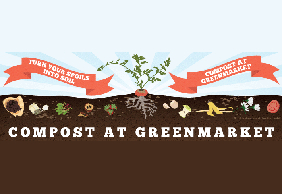In 2013, former Mayor Bloomberg committed to diverting 75% of New York City’s waste from landfills by 2030. City efforts to reduce food waste take many forms, including:
- Mayor’s Food Waste Challenge: With a goal of reducing landfilled food waste by 50%, Mayor Bloomberg invited New York City Restaurants to participate in the Mayor’s Food Waste Challenge. Learn more about the structure and benefits of the Food Waste Challenge.
- Local Law 77 of 2013, requiring the NYC Department of Sanitation to establish a voluntary residential organic waste curbside collection pilot program as well as a school organic waste collection pilot program. Read the Organics Collection Pilot Program Report
- Local Law 146 of 2014, mandating that businesses generating over one ton of food waste weekly must source separate and divert their organic waste beginning in July 2015.
- General information for residents, schools and businesses to support source reduction and food waste diversion
The most visible of these efforts has been the Organics Collection Pilot Program reaching a few selected residential communities spanning all 5 boroughs and public schools across the city. Though food loss occurs at many points in our food system, these numbers present a snapshot of New York City’s progress in diverting food scraps (at the consumer and institutional level) from landfill.
Of the 31% of residential waste that is suitable for composting, food waste comprises 18%.
Organic waste collected by DSNY curbside and containerized collections, in tons per day: October 2014 and October 2013,

These numbers include Christmas trees, leaves and yard waste, food waste, Green market* waste and SchoolFood Waste. These programs are not citywide, and some are seasonal. *It is unclear if the term “green market” refers to only Greenmarket farmers markets or if it includes other farmers markets throughout the city.
New York City residents, institutions and businesses produce more than 24,000 tons per day of municipal solid waste. In FY2013 the NYC Department of Sanitation was responsible for collecting 11,500 tons per day. In this context, organics comprise a relatively small proportion of solid waste. However, with over $161 billion of food wasted in the United States in 2010, or 30-40 percent of our food supply, any amount of food that can be diverted from landfill in the form of donated food, compost, or the many other uses for unwanted food (see our recap of UPENN’s “The Last Food Mile” Conference) is a positive change.
Back to NYC Food by the Numbers main page>>
December 11, 2014


